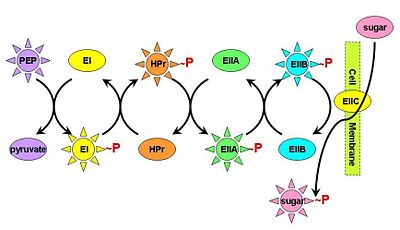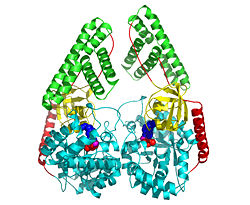Enzyme I of the Phosphoenolpyruvate:Sugar Phosphotransferase System
From Proteopedia
Contents |
Enzyme I of the PTS - a Molecular machine
- VIDEO of the PTS Enzyme in Action
- VIDEO of the Pyruvate Phosphate Dikinase Enzyme in Action
- Video source: Osnat Herzberg Group
Bacteria evolved a unique mechanism to import many carbohydrates, the phosphoenolpyruvate:sugar phosphotransferase system (PTS). The PTS synchronizes the transport and phosphorylation of the sugar (group translocation), engaging several proteins in a five steps phosphorylation cascade. With some variations, the PTS comprises three proteins: In the cytoplasm, PEP phosphorylates Enzyme I (EI), which then transfers the phosphoryl group to the histidine phosphocarrier protein, HPr. From HPr, the phosphoryl group is transferred to various sugar-specific membrane associated transporters (EnzII), each comprising two cytoplasmic domains, EIIA and EIIB, and an integral membrane domain EIIC. Within EII, EIIA accepts the phosphoryl group from HPr and donates it to EIIB, whereupon EIIC mediates sugar translocation with EIIB providing the phosphoryl group. In addition to controlling sugar translocation, the phosphorylation state of PTS proteins is also associated with regulation of metabolic pathways and signaling in bacterial cells.
The ~64 kD EI is a homodimers that requires Mg2+ for phosphorylation by PEP. Each subunit comprises three domains: PEP binds to the C-terminal domain (adopting an α/β barrel fold) and HPr binds to the N-terminal domain (an α-helix bundle). A central domain, tethered to the N-terminal domain by two closely associated linkers and to the C-terminal domain by a long α-helix, contains a phosphorylatable histidine residue (His189). The crystal structure of Escherichia coli EI was obtained by using Mg2+ and PEP to phosphorylate EI and than adding oxalate (a pyruvate analog). In this structure, His189 is phosphorylated and oriented for in-line phosphotransfer to/from the ligand. Thus, the structure represents an enzyme intermediate just after phosphotransfer from PEP and prior to a conformational transition that brings His189~P in proximity to the phosphoryl group acceptor, His15 of HPr. A model of this conformational transition invokes swiveling around the α-helical linker that disengages the His-domain from the PEP-binding domain. Assuming that HPr binds to the HPr-binding domain as observed by NMR spectroscopy of an EI fragment, a rotation around the two linker segments orients the His-domain relative to the HPr-binding domain so that His189~P and His15 are appropriately stationed for an in-line phosphotransfer reaction. The crystal structure of apo-EI from Staphylococcus carnosus supports this model.
The movie depicts the phosphotransfer from PEP to EI and from EI to HPr and the accompanying protein conformational transitions. This is a model based on crystal structure of the intact E. coli EI and the NMR model of the fragment containing the HPr-binding domain and the His-domain in complex with HPr. The HPr-binding domain is colored blue. The PEP-binding domain is colored cyan, the His-domain is colored yellow, and the linker segments that connect the His-domain to the partner domains are colored red. Hpr is colored green. Ligands and the catalytic histidine are depicted in stick models with the atomic color scheme: Carbon – gray, Nitrogen – blue, Oxygen – red, Phosphorous – green, Magnesium – magenta. The movie was created by Kap Lim and osnat Herzberg
Additional Resources
Larger movie frame for classroom projection
For additional information, see: Membrane Channels & Pumps
For additional information, see: Photosynthesis
Key References
- Teplyakov A, Lim K, Zhu P-P, Kapadia G, Chen CCH, Schwartz J, Howard A, Reddy PT, Peterkofsky A, Herzberg O. (2006). Signaling sugar translocation: Structure of phosphorylated Enzyme I of the phosphoenolpyruvate:sugar phosphotransferase system. Proc. Natl. Acad. Sci. USA 103, 16218-16223.
- Marquez, J. A., Reinelt, S., Koch, B., Engelmann, R., Hengstenberg, W., & Scheffzek, K. (2006). Structure of the full-length enzyme I of the phosphoenolpyruvate-dependent sugar phosphotransferase system. J. Biol. Chem. 27, 32508-32515.
- Garrett, D. S., Seok, Y. J., Peterkofsky, A., Gronenborn, A. M., & Clore, G. M. (1999). Solution structure of the 40,000 Mr phosphoryl transfer complex between the N-terminal domain of enzyme I and HPr. Nat. Struct. Biol. 6, 166-173.
3D Structures of EI
Proteopedia Page Contributors and Editors (what is this?)
Osnat Herzberg, Eric Martz, David Canner, Michal Harel, Jaime Prilusky, Karl Oberholser, Eran Hodis


